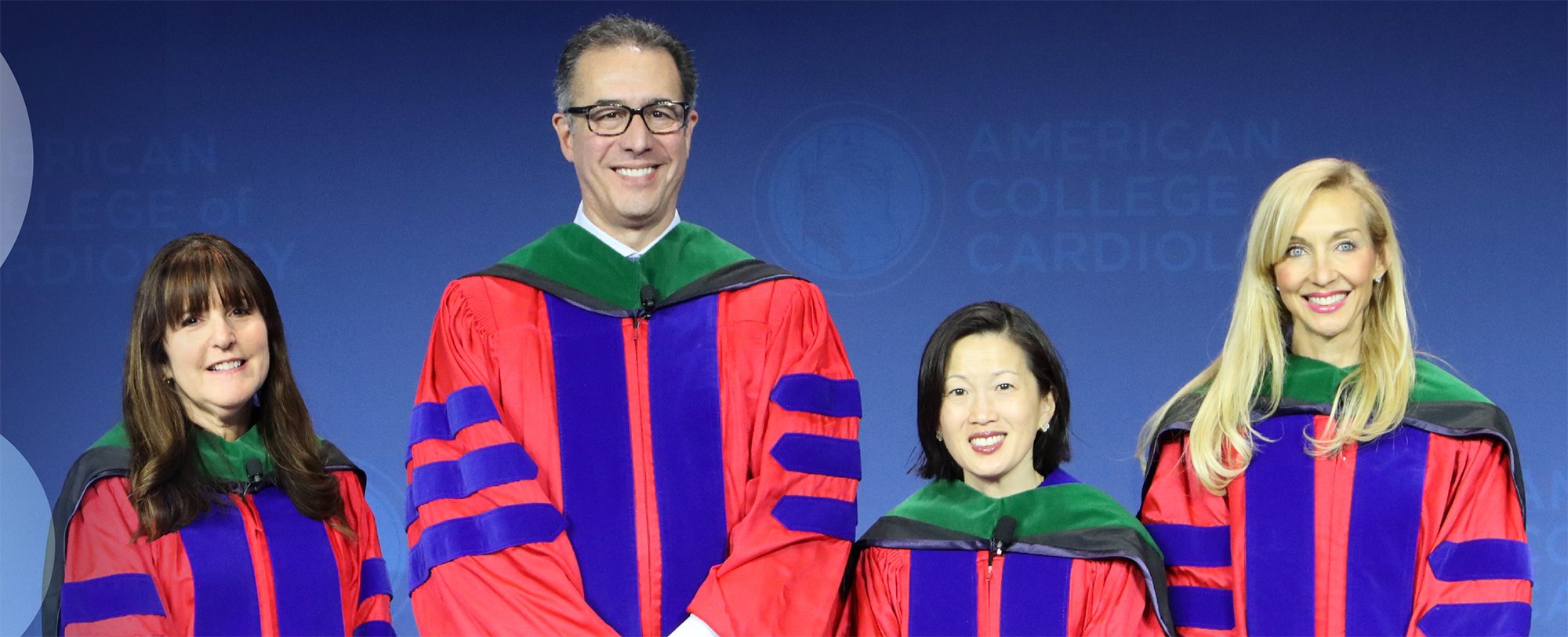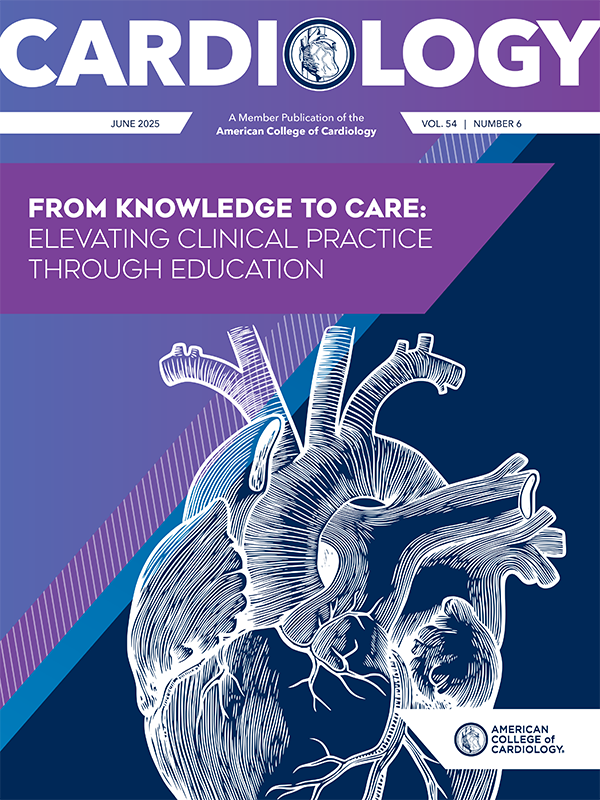Feature | Four Scientists, Four Questions

In recognition not just of individual excellence, but of the critical role science plays in shaping the future of cardiovascular care, four pioneering cardiovascular researchers were recognized with ACC Distinguished Awards as part of ACC.25 in Chicago. Taken together, their work has helped contribute to the body of evidence surrounding cardiac biomarkers, cardio-oncology, cardiac rheumatology and the role of platelets in thrombosis.
Jane E. Freedman, MD, FACC; James L. Januzzi Jr., MD, FACC; and Bonnie Ky, MD, MSCE, FACC, were named recipients of ACC's 2025 Distinguished Scientist Awards in Basic, Clinical, and Translational Science, respectively – underscoring the interconnected efforts that span from the lab to the patient bedside. Brittany Weber, MD, PhD, FACC, received the 2025 Douglas P. Zipes Distinguished Young Scientist Award, marking her as a rising leader in the field.
Given the vital importance of scientific discovery and innovation in reducing the global burden of cardiovascular disease, Cardiology asked each of the awardees to share insights about their careers, their current research and what they hope to accomplish in the future.

What motivated you to focus on your particular area of cardiovascular research, and what recent breakthroughs or discoveries are you most excited about?
Freedman: I first became interested in thrombosis, vascular biology and platelets as a research technician when I was asked to study blood from a patient with coronary ischemia. I wondered then, as I do now, why does this specific person have a myocardial infarction (MI) and thrombosis and not another person?
Januzzi: It was during my Junior Residency at Brigham and Women's Hospital that cardiac troponin testing was introduced, leading to a complete alteration in my career trajectory. Here was a highly specific blood test for MI that had important biological tie-ins to the presence of thrombosis and heart injury. It allowed me to link up my interest in molecular biology with my love of clinical medicine.
Ky: I have always been curious and love asking questions and finding answers. As a cardiology fellow, I became really excited by a translational science manuscript that I read in JACC, focused on a specific signaling pathway perturbed by cancer therapies. Under the mentorship of Thomas Cappola, MD, FACC, and Stephen Kimmel, MD, FACC, I studied this pathway in human heart failure and the next steps were to apply this understanding to patients treated with cardiotoxic cancer therapies, to gain insights into mechanistic risk prediction.
Weber: My interest in cardio-rheumatology as a research focus spiked at a young age. I had the opportunity to do scientific research at the Oklahoma Medical Research Foundation after high school and I joined a lab focused on understanding lupus and B-cell tolerance. I fell in love with science, and I still remember seeing my first patient with lupus. I learned what a physician-scientist was and started my journey to become one – pursuing a PhD in immunology and finding my clinical passion in cardiology.

What are the biggest challenges in predicting, preventing or treating cardiovascular diseases, and how is your research addressing them?
Freedman: Cardiovascular disease is difficult to predict, prevent and treat because it is highly multifactorial. The causes are complex and patient dependent. The simpler, easy targets have been deduced and now many investigators are trying to understand the variability between people and how we can target each individual's disease and risk. We have been addressing them by taking our basic observations and studying them in large populations to understand the complexities of this disease.
Januzzi: There are two large challenges in predicting, preventing and treating cardiovascular disease, and our research addresses both. First, is having more widespread access to tools to better recognize and manage cardiovascular risk. There are many ways to identify risk, but many require specialized imaging and interpretation, and many are costly. Biomarkers are widely available – and increasingly so – are easily interpreted and inexpensive relative to other means of risk stratification. Second, once risk is established, the other challenge is accurately applying the therapies that we know are of benefit. Through our research, we can now more confidently treat patients who are most likely to benefit, applying therapies in the most precise and cost-effective manner.
Ky: Some of the biggest challenges – or opportunities as I prefer to think of them – lie in using detailed phenotyping to determine individual patient characteristics associated with increased risk of cardiovascular disease. This would allow for the development of innovative cardioprotective strategies and enable us to target cardioprotection according to risk. To do this, we need large patient cohorts, more accurate and precise individual-level patient data on cancer and cardiovascular disease risk, and a greater understanding of disease mechanisms.
Weber: The challenge lies at multiple levels. First, we need better awareness and knowledge of the increased risk of cardiovascular disease within autoimmunity. Second, we need future guidelines for risk assessment within these diseases. However, each disease is quite different than the other and each has varying levels of cardiovascular risk, thus disease-specific risk prediction is needed. Furthermore, there is heterogeneity within each disease, so precision is needed. Treatment is also multi-layered, requiring knowledge of the various immunotherapies, their impact on cardiovascular risk and appropriate cardiovascular prevention pharmacotherapies.
Our research has focused on how we can use multimodality imaging to identify cardiovascular risk within these diseases, such as coronary microvascular dysfunction, as well as other biomarkers of risk. We have also tested whether anti-inflammatory biologic therapy can reduce cardiovascular risk. Our mechanistic studies have focused on common immune-mediated inflammatory diseases-including rheumatoid arthritis (RA), psoriasis and lupus.

How do you see your work influencing the future of heart disease treatment, patient care or prevention strategies?
Freedman: I hope my studies help people realize that the formation of clots and thrombosis is not as simple as platelets sticking to the vessel wall. Our basic and large population data have clearly shown that other factors may impact these processes such as infections and immunity.
Januzzi: Biomarkers are an important part of how cardiovascular care is being transformed: they are used in all phases of clinical trials to develop novel therapies for heart disease, and they are now used by clinicians to diagnose, treat and monitor patients with various diseases states. The future will include the use of biomarkers to even more closely manage patients in the home environment, allow for earlier and earlier diagnosis and risk assessment for various cardiovascular disease states, and ultimately will lead us to the era of precision medicine in cardiology.
Ky: Our work has advanced innovative approaches in defining cardiovascular risk in patients with cancer through detailed cardiovascular phenotyping of survivors of adult and childhood cancers through imaging, biomarkers and social determinants, and leading mechanistic trials in risk-guided cardioprotection. Our premise is that cardiovascular disease is detectable, treatable and preventable, and ultimately, we seek to promote longer, healthier lives for our patients. As Editor-in-Chief of JACC: CardioOncology, we have worked to accelerate the growth of the global field of cardio-oncology through a focus on rigorous science, the patient and the community.
Weber: Community and collaboration are essential. My hope is that our work can increase awareness among the medical community and among patients on a global scale. Cardio-rheumatology is evolving and there are still very few specialized clinics in the U.S. As a field, we need to think about future training models, akin to what has been done with the more advanced fields of cardio-oncology, for instance. I do believe the incorporation of imaging will be important in the field of cardio-rheumatology. Knowledge of the rapidly expanding targeted biologic treatments is also needed on a more mechanistic level, along with how they impact the cardiovascular system.

What are the next steps in your research, and what advancements do you anticipate over the next five to 10 years?
Freedman: The next steps are to continue to partner with other investigators to develop areas that can be specifically targeted to both diagnose, prevent and treat thrombotic diseases and potentially modulate infection.
Januzzi: The future is now for home-based biomarker monitoring for various disease states, including smartphone-leveraged testing for NT-proBNP, kidney function and electrolytes. Beyond this, at the Massachusetts General Hospital Heart and Vascular Institute, we are perfecting newer means by which to test troponin, which may fundamentally change how this test is performed. At the Baim Institute for Clinical Research, we are discovering new biological pathways and individual biomarkers through proteomic testing; this may inform better therapies for cardiovascular disease. Additionally, at Baim, we are also using biomarkers to better refine clinical trial design and execution.
Ky: We will continue to grow our work in precision phenotyping and risk-guided cardioprotection through larger, more definitive clinical trials. Important advancements over the next five to 10 years will be in artificial intelligence and machine learning and in the development of new mechanistic therapies that can prevent both cancer and cardiovascular disease.
Weber: Further work on the role of imaging, including novel imaging metrics of cardiovascular risk; immunophenotyping within individual diseases; clarification of cardioprotection roles of cardiovascular drugs; and testing of immunotherapies is needed on a broad level. These advancements are exciting for me to think about. Advances in imaging and the era of the "omics" are here, as well as our ability to dissect the immune response down to a single cell level. I believe we will see advancement in our ability to identify and treat cardiovascular risk earlier and that will help us achieve our ultimate goal of prevention. This is, at least, my dream.
Keywords: Cardiology Magazine, ACC Publications, Biomedical Research, Translational Medical Research, Awards and Prizes, Physicians
